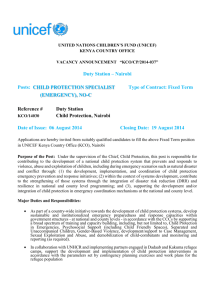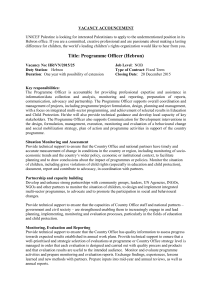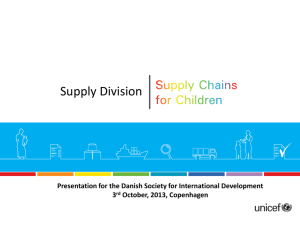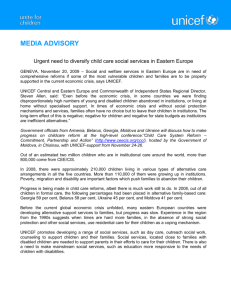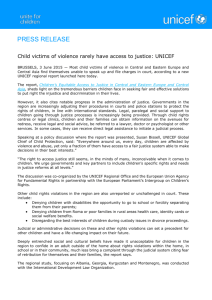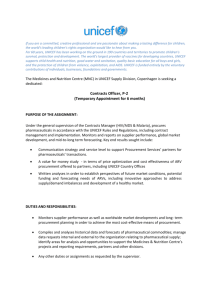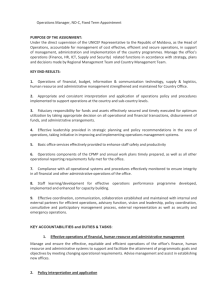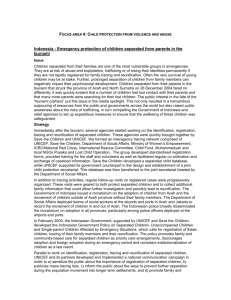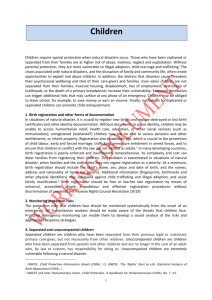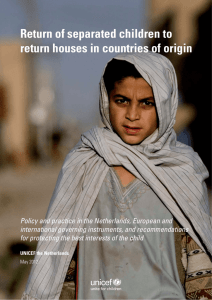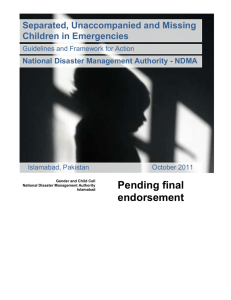Draft-ToR-Rapid-FTR-Monitoring-18-July-for-advert
advertisement
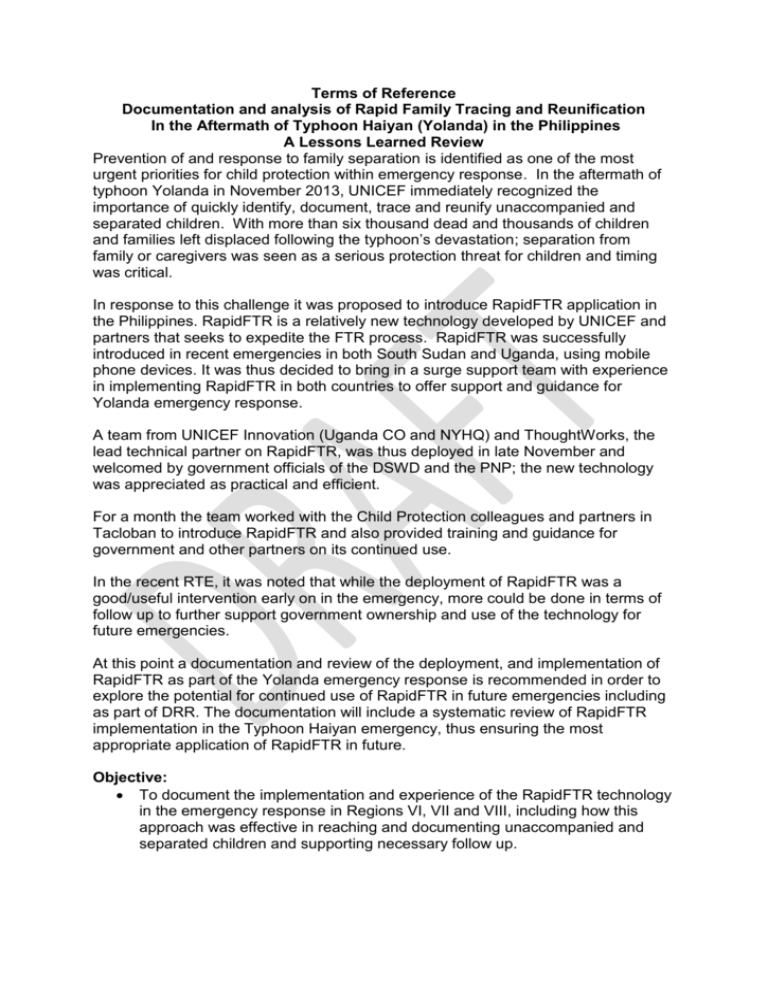
Terms of Reference Documentation and analysis of Rapid Family Tracing and Reunification In the Aftermath of Typhoon Haiyan (Yolanda) in the Philippines A Lessons Learned Review Prevention of and response to family separation is identified as one of the most urgent priorities for child protection within emergency response. In the aftermath of typhoon Yolanda in November 2013, UNICEF immediately recognized the importance of quickly identify, document, trace and reunify unaccompanied and separated children. With more than six thousand dead and thousands of children and families left displaced following the typhoon’s devastation; separation from family or caregivers was seen as a serious protection threat for children and timing was critical. In response to this challenge it was proposed to introduce RapidFTR application in the Philippines. RapidFTR is a relatively new technology developed by UNICEF and partners that seeks to expedite the FTR process. RapidFTR was successfully introduced in recent emergencies in both South Sudan and Uganda, using mobile phone devices. It was thus decided to bring in a surge support team with experience in implementing RapidFTR in both countries to offer support and guidance for Yolanda emergency response. A team from UNICEF Innovation (Uganda CO and NYHQ) and ThoughtWorks, the lead technical partner on RapidFTR, was thus deployed in late November and welcomed by government officials of the DSWD and the PNP; the new technology was appreciated as practical and efficient. For a month the team worked with the Child Protection colleagues and partners in Tacloban to introduce RapidFTR and also provided training and guidance for government and other partners on its continued use. In the recent RTE, it was noted that while the deployment of RapidFTR was a good/useful intervention early on in the emergency, more could be done in terms of follow up to further support government ownership and use of the technology for future emergencies. At this point a documentation and review of the deployment, and implementation of RapidFTR as part of the Yolanda emergency response is recommended in order to explore the potential for continued use of RapidFTR in future emergencies including as part of DRR. The documentation will include a systematic review of RapidFTR implementation in the Typhoon Haiyan emergency, thus ensuring the most appropriate application of RapidFTR in future. Objective: To document the implementation and experience of the RapidFTR technology in the emergency response in Regions VI, VII and VIII, including how this approach was effective in reaching and documenting unaccompanied and separated children and supporting necessary follow up. To document and understand the acceptance and application of RapidFTR by government partners and communities, including community perceptions and understanding of the utility and importance of RapidFTR. To consider the possible impact of RapidFTR in strengthening Child protection systems that existed in communities prior to the emergency, including through training and capacity building on RapidFTR use. Document and analyse the effectiveness of the process of adapting RapidFTR in the aftermath of Typhoon Haiyan, thus providing guidance for future emergencies on how to deploy RapidFTR, including to ensure sustainability and necessary follow-up procedures are established, particularly to reach the most vulnerable and isolated communities. To review and follow up on issues raised from initial RapidFTR mission report including 1. Attention to previously existing UASC cases 2. Older Unaccompanied Children who fled the area in search of employment; noting the risk of migration, and trafficking 3. Need for greater community understanding around the concept of “unaccompanied or separated”; or “children who have lost both parents and may need support” Document and assess RapidFTR implementation in the Philippines against global and national minimum standards. Provide recommendations for RapidFTR training/capacity building in DRR. Explore prospects for greater ownership and involvement with RapidFTR by government partners. Background: RapidFTR is one of the pillars of the UNICEF child protection’s immediate response to the needs of children in emergencies, and an entry point for working with affected communities. Raising awareness on the importance of preventing family separation, as well as the need to immediately identify, register and trace the families and caregivers of children who are separated, are critical for urgent advocacy, recognizing that separated children are at greater risk of exploitation, abuse and violence, including trafficking. Broadly, the purpose of RapidFTR is to expedite the Family Tracing and Reunification process by ensuring that children who are separated from their families and caregivers in the aftermath of an emergency are identified and documented as quickly as possible, and that government social workers and authorities are aware of and can conduct necessary follow up with children who are unaccompanied and separated. In the wake of the Typhoon Yolanda, the CP in Emergencies team deployed RapidFTR (www.rapidftr.com, rapid family tracing and reunification) to respond to the needs of Separated and Unaccompanied children in the affected areas. RapidFTR’s development has been led by UNICEF on behalf of the global Inter-Agency Working Group for Unaccompanied and Separated Children. To support the deployment of this tool, Cary McCormick of UNICEF Uganda, Mac Glovinsky of UNICEF NY, and two software developers from Thoughtworks India (provided pro bono) surged to Tacloban approximately 10 days after the international call for assistance from the Philippines government. The team, led by IRT CPIE Specialist, Ms. Pernille Ironside, undertook deployment of RapidFTR in Tacloban for approximately four weeks. The primary objective of the mission was to support the identification of cases of highly vulnerable children, particularly unaccompanied and separated children, through the use of RapidFTR. Support was provided particularly to the PNP WCPDO / MSWDO officers responsible for identifying these vulnerable children in their affected areas and ensuring that they were connected to government support services if necessary. The initial mission targeted locations according to the following criteria: Leyte: Based on casualty and “# of missing persons” statistics, targeting 3 municipalities (Tolosa, Tanauan, Palo) and City of Tacloban. Pairs of MSWDO and WCPD from these areas received an Android smartphone to facilitate recording of the cases. Samar: Based on statistics, targeting 3 municipalities – Hernani, Salcedo, and Guiuan RapidFTR documented 118 cases of separated children as of January 2014. The initial mission also provided training to the Government of Philippines in the use and maintenance of the RapidFTR system as follows: Leyte: MSWD and WCPD from 22 municipalities in Leyte Team conducted 1-on-1 training sessions by visiting each pair of officers and walking through the barangays with them as they searched for initial cases System can function when there is no internet signal. Team visited each location every three days in order to help synchronize records from the phones. Team also established and trained IT support at PSWD Leyte office Samar Trained MSWD and WCPD from 9 municipalities in Eastern Samar on December 4, 2013 Team conducted 1-on-1 coaching in Hernani on Dec 5, and in Guiuan and Salcedo Synchronization support sites decided on in Borongan and Guiuan SIM cards ordered for all municipalities so that there is no need to travel in order to sync once the internet connection is back The Government of Philippines took ownership of RapidFTR, with dedicated resources (supported by UNICEF). The national CWC (Council on the Welfare of Children), advised that RapidFTR would be part of the government’s 2014 strategic plan Government dedicated resources (staff) of DSWD in Tacloban will maintain system and manage website UNICEF Child Protection Specialist (Jess Far) was tasked with oversight of the system, supported by additional staff in CP section All assets brought by surge team (phones, laptops, routers, solar suitcases) in custodianship of UNICEF Tacloban office and GoP. Trainings and workshops were conducted with members of the government to build capacity/expertise in RapidFTR implementation. Further work/capacity building and guidance on RapidFTR is also included within the Strategic Response Plan and within the PCAs currently being implemented by UNICEF partners. Focus of Documentation: 1. RapidFTR as a component of CP Systems Document the role of RapidFTR within existing Child Protection systems 2. Advocacy and Awareness Raising on family separation and RapidFTR Adoption and Standardization of RapidFTR, use of Minimum Standards and monitoring tools by partners Mapping knowledge, buy in, and involvement of the community 3. Training and Capacity Building, and M and E Availability of human resource personnel to adapt and utilize RapidFTR Training conducted and outcomes Forms and tools used by partners to monitor activities Frequency of monitoring of UAMs Feedback mechanisms for children, parents, and others RapidFTR global and national guidelines Review of recommended follow up from RapidFTR mission report 4. Review of UNICEF partnerships with agencies including Plan, Save, and Child Fund regarding attention to FTR follow up; monitoring the situation of vulnerable children, and referring cases to MSWDO, and identification and follow-up as included in PCAs. 5. Asses how GoP could use RapidFTR as a DRR and anti-trafficking tool, with support from UNICEF 6. Examine UNICEF Support/Facilitation/Promotion to the GoP on the maintenance and expansion of RapidFTR both as a DRR element for coming emergencies and a case management tool for current emergencies. Deliverables: Descriptive and analytical review of field missions to document RapidFTR implementation. Documentation of meetings/discussions with government and other partners as well as UNICEF staff concerning RapidFTR implementation. Reports from FGDs with children and caregivers concerning perceptions towards and use of RapidFTR. Mapping of RapidFTR deployment; where did work proceed, what areas were accessed/not accessed. Analysis of supplies necessary for RapidFTR, and recommendation for procurement for future emergencies. Assessment of benefit of RapidFTR for different categories of children, from an equity perspective. Analysis of recommendations from initial RapidFTR mission and follow up. Extensive report detailing systematic data collection and documentation of monitoring visits to areas where RapidFTR was implemented, offering insight into challenges, successes, and lessons learned for future emergencies in the Philippines. Required Skills/Experience Academic qualification and field experience in Child Protection in Emergency; preferably a Masters’ degree in social work or social science, law, human rights, social policy, psychology or other fields related to social development and humanitarian work. A minimum of 5-7 years combined experience in child protection or related fields, including emergency work and preferably with experience in family separation prevention and response. Experience in conducting evaluations, particularly concerning child protection work in emergency. Knowledge and understanding of child protection systems, including policies, legislation, procedures and protocols. Fluent in English and knowledge of Filipino languages an asset Excellent writing and communication skills

